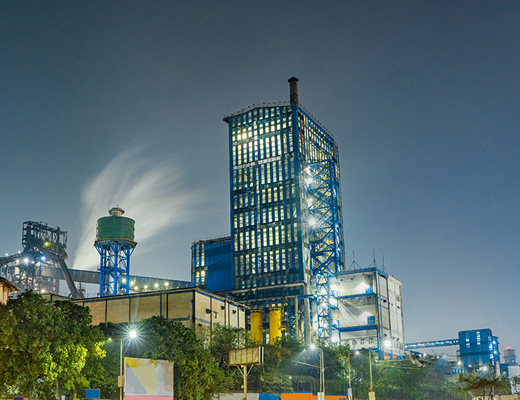Jharkhand
Jharkhand is the only state in India to produce coking coal, uranium, and pyrite. The state is also a leading producer of coal, mica, kyanite and copper.


Introduction

Jharkhand is located in the eastern part of India. The state shares its borders with West Bengal in the east, Uttar Pradesh and Chhattisgarh in the west, Bihar in the north and Odisha in the south. In India, Jharkhand is one of the leading states in terms of economic growth. At current prices, Jharkhand’s gross state domestic product (GSDP) was estimated to stand at ~Rs. 5.56 trillion (US$ 64.61 billion) in FY26. The GSDP increased at a CAGR of 10.41% between FY16 and FY26.
Jharkhand is one of the richest mineral zones in the world and boasts 40% and 29% of India's mineral and coal reserves, respectively. Due to its large mineral reserves, mining and mineral extraction are the major industries in the state. Mineral production in the state stood at 138.15 million tonnes in FY23.
Jharkhand is rich in mineral resources such as coal (27.3% of India’s reserves), iron ore (26% of India’s reserves), copper ore (18.5% of India’s reserves), uranium, mica, bauxite, granite, limestone, silver, graphite, magnetite, and dolomite. Jharkhand is the only state in India to produce coking coal, uranium, and pyrite. With 26% of the total iron ore (hematite) reserves, Jharkhand ranks second among the states.
The state’s industries enjoy a unique location-specific advantage as it is close to the vast market of eastern India. It is closer to the ports of Kolkata, Haldia, and Paradip which helps in the transportation of minerals.
According to the Department for Promotion of Industry and Internal Trade (DPIIT), cumulative foreign direct investment (FDI) inflows in Jharkhand stood Rs. 22,903 crore (US$ 2.66 billion) between October 2019-December 2024.
As of March 2023, the number of IEMs filed were 3 and the value of proposed investments stood at Rs. 424 crore (US$ 51.6 million).
Total exports from the state stood at Rs. 15,498 crore (US$ 1.8 billion) in FY25 (until February 2025).
Major items exported from Jharkhand are Engineering Goods, Mica, Coal and Other Ores, Minerals Including Process, and Iron Ore.
As of FY25 (until March 2025), Jharkhand had a total installed power generation capacity of 3008.35 MW, comprising 800.01 MW under private utilities, 554.05 MW (state utilities), and 1654.29 MW (central utilities).
Under the State Budget FY26, Rs. 5,005 crore (US$ 581.3 million) has been allocated as power subsidy for consumers.
According to the Telecom Regulatory Authority of India (TRAI), Bihar including Jharkhand had 94.86 million wireless and 1.37 million wireline subscribers, as of Dec 2024.
As of Dec 2024, teledensity in the state stood at 56.44%.
Jharkhand offers a wide range of fiscal and policy incentives to industries, under the Industrial Policy, 2012. The state also has policies for IT and special economic zones (SEZs) offering sector-specific incentives, as well as the Jharkhand Energy Policy 2012 which aims to supply reliable and quality power in an efficient manner at a reasonable price.
About 80% of the rural population of the state depends on agriculture. Rice is the major food crop of the state, covering 80% of the cropped area.
Recent Developments
- In October 2024, Union Minister Mr. Satish Chandra Dubey has laid the foundation stone of two coal handling projects worth Rs 732 crore (US$ 87.77 million) in Jharkhand.
- In September 2024, the central government announced a budget of over Rs. 7,000 crore (US$ 839.33 million) for the development of rail infrastructure in Jharkhand.
- In August 2023, TCPL Green Energy Solutions (TCPLGES), a wholly-owned subsidiary of Tata Cummins Private Limited (TCPL), signed a Memorandum of Understanding with the Government of Jharkhand to set up a manufacturing plant to produce low-to-zero-emission technologies for mobility solutions and announced to invest Rs. 350 crore (US$ 42 million) over the next few years.
- In four years (2018-19 and 2021-22), Jharkhand attracted new investment proposals of over Rs. 1.10 lakh crore (US$ 13 billion) completed projects of Rs. 52,893 crore (US$ 6.45 billion), and revived pending proposals worth Rs. 287.45 crore (US$ 35.1 million), according to the study jointly conducted by the MSME Export Promotion Council and the Confederation of Organic Food Producers & Marketing Agencies (COII).
- Union Minister of Roads Transport and Highways, Mr. Nitin Gadkari, in March 2023, promised to bolster infrastructure in Jharkhand and asserted that Rs. 2 lakh crore (US$ 24 billion) highway network will be rolled out in the state by 2024.
- In March 2024, Union Minister for Road Transport & Highways, Mr Nitin, laid foundation stone of two National Highway projects at a cost of more than Rs. 2500 crore (US$ 301.93 million) in a program organized yesterday in Khunti, Jharkhand.
- Prime Minister Mr. Narendra Modi inaugurated the Deoghar airport in July 2022, which has been constructed at an estimated cost of Rs. 400 crore (US$ 48.8 million). The Terminal Building of the airport is equipped to handle over five lakh passengers annually.
- The Jharkhand government unveiled an ambitious new solar policy (Jharkhand Solar Policy, 2022) which is aimed at increasing clean energy capacity up to 4,000 megawatts in the next five years.
- Jharkhand has one Jharkhand State Open University (JSOU), 20 State Public Universities, and 15 State Private Universities.
- As per the State Budget 2024-25, the government allocated Rs. 6,017 crore (US$ 726.69 million) for the agriculture and allied activities sector.
- The state cabinet on September 29, 2022, approved the draft of the Jharkhand Industrial Parks and Logistics Policy, 2022. Effective for the next five years, the policy is aimed at boosting the industrial infrastructure in Jharkhand by wooing private players to set up industrial parks by providing financial subsidies up to Rs. 75 crore (US$ 9.2 million).
Key Sectors
- Major allocation under state budget FY26:
- Rs. 5,300 crore (US$ 615.6 million) has been allocated as capital outlay on roads and bridges.
- Rs.130 crore (US$ 15.1 million) has been allocated for urban transport systems and civic amenities in Urban Local Bodies (ULBs) and Rs. 200 crore (US$ 23.2 million) for other amenities.
- Rs. 2,057 crore (US$ 238.9 million) has been allocated towards Sarva Siksha Abhiyan.
- Rs. 1,769 crore (US$ 205 million), while the National Ayush Mission has been allocated Rs. 168 crore (US$ 19.5 million).
- Rs. 212 crore (US$ 24.6 million) for the State Horticulture Development Scheme and Rs. 140 crore (US$ 16.3 million) for distributing agricultural equipment to farmers and women self-help groups (SHGs).
- To commemorate World Tribal Day, Jharkhand Chief Minister Mr. Hemant Soren said that the state government would provide farming machinery, equipment, and other items worth Rs. 734 crore (US$ 100 million) to 2 lakh farmers in August 2021.
- The state's raw silk production stood at 2,402 MT in FY20, 2184 MT in FY21, 1,046 in FY22 and 874 MT in FY23.
- The natural resources, policy incentives and location-specific advantages of Jharkhand support investments in sectors such as mining and metal extraction, engineering, iron and steel, and chemicals.
- As Jharkhand has around 40% of the country’s mineral wealth, its extensive mineral resources make mining, metals, and related sectors especially lucrative for investments.
- The major growth drivers of the engineering industry in Jharkhand are the availability of raw materials (iron and steel, aluminium, copper and other metals and non-metals), power, water, and industrial labour.
- In 2021-22, the total production of vegetables and fruits was at 3,818.21 thousand metric tonnes and 1,312.18 thousand metric tonnes, respectively.
- As per the Economic Survey of Jharkhand 2022-23, the total cultivated area under kharif crops stood at 2,536.28 thousand hectares in 2021-22, of which paddy occupies ~69.5% of the total area.
FACTFILE
Capital
RanchiGeographical Area (sq km)
79,714State Language
Hindi, Santhali, Urdu, Bengali and EnglishLiteracy Rate
66.4 per centKey Industries:
Mining and mineral extraction
Iron and steel
Engineering
Chemicals





